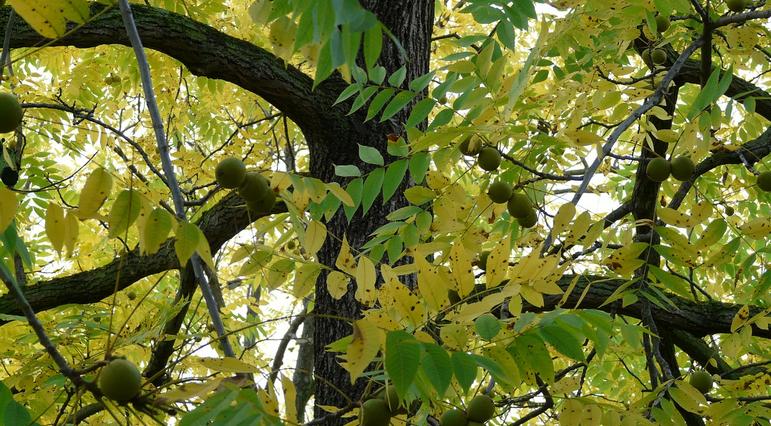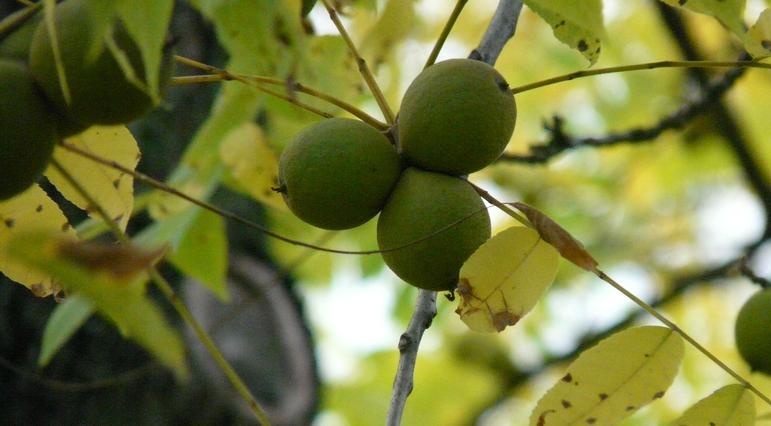Planting Near Black Walnut Trees

Learn why many plants have a hard time growing near black walnut trees and which plants grow well near them.
The roots of the Black Walnut (Juglans nigra L.) and butternut (Juglans cinerea L.) produce a substance known as juglone (5-hyroxy-alphanapthaquinone). Persian (English or Carpathian) walnut trees are sometimes grafted onto black walnut rootstocks. Many plants such as tomato, potato, blackberry, blueberry, azalea, mountain laurel, rhododendron, red pine and apple may be injured or killed within one to two months of growth within the root zone of these trees. The toxic zone from a mature tree occurs on average in a 50 to 60 foot radius from the trunk, but can be up to 80 feet. The area affected extends outward each year as a tree enlarges. Young trees two to eight feet high can have a root diameter twice the height of the top of the tree, with susceptible plants dead within the root zone and dying at the margins.
Not all plants are sensitive to juglone. Many trees, vines, shrubs, groundcovers, annual and perennials will grow in close proximity to a walnut tree. Certain cultivars of “resistant” species are reported to do poorly. Black walnut has been recommended for pastures on hillsides in the Ohio Valley and Appalachian mountain regions. Trees hold the soil, prevent erosion and provide shade for cattle. The beneficial effect of black walnut on pastures in encouraging the growth of Kentucky bluegrass (Poa pratensisL.) and other grasses appears to be valid as long as there is sufficient sunlight and water.
Gardeners should carefully consider the planting site for black walnut, butternut or Persian walnut seedlings grafted to black walnut rootstock, if other garden or landscape plants are to be grown within the root zone of mature trees. Persian walnut seedlings or trees grafted onto Persian walnut rootstocks do not appear to have a toxic effect on other plants.
Horses may be affected by black walnut chips or sawdust when they are used for bedding material. Close association with walnut trees while pollen is being shed (typically in May) also produce allergic symptoms in both horses and humans. The juglone toxin occurs in the leaves, bark and wood of walnut, but these contain lower concentrations than in the roots. Juglone is poorly soluble in water and does not move very far in the soil.
Walnut leaves can be composted because the toxin breaks down when exposed to air, water and bacteria. The toxic effect can be degraded in two to four weeks. In soil, breakdown may take up to two months. Black walnut leaves may be composted separately, and the finished compost tested for toxicity by planting tomato seedlings in it. Sawdust mulch, fresh sawdust or chips from street tree prunings from black walnut are not suggested for plants sensitive to juglone. However, composting of bark for a minimum of six months provides a safe mulch even for plants sensitive to juglone.
Friends of the Black Walnut:
PERENNIALS:
|
Ajuga reptans (Bugleweed) |
Monarda fistulosa (Wild Bergamot) |
|
Alcea rosea (Hollyhock) |
Oenothera fruticosa (Sundrops) |
|
Asarum europaeum (European Wild Ginger) |
Onoclea sensibilis (Sensitive Fern) |
|
Astilbe |
Osmunda cinnamomea (Cinnamon Fern) |
|
Campanula spp. (Bellflower) |
Phlox paniculata (Summer Phlox) |
|
Chrysanthemum (Hardy Chrysanthemum) |
Polemonium reptans (Jacob’s Ladder) |
|
Doronicum (Leopard’s Bane) |
Polygonatum commutatum (Solomon’s Seal) |
|
Dryopteris cristata (Crested Wood Fern) |
Primula x polyantha (Primrose) |
|
Galium odoratum (Sweet Woodruff) |
Pulmonaria (Lungwort) |
|
Geranium robertianum (Herb Robert) |
Sanquinaria Canadensis (Bloodroot) |
|
Geranium sanquineum (Cranesbill) |
Sanquinaria Canadensis multiplex (double- |
|
Helianthus tuberosus (Jerusalem Artichoke) |
flowered bloodroot, Sedum acre, gold moss |
|
Hemerocallis fulva (Common Daylily) |
Stachys byzantina (Lambs Ear) |
|
Heuchera x brizoides Pluie de Feu, (Coral Bells) |
Tradescantia virginiana (Spiderwort) |
|
Hieracium aurantiacum (Orange Hawkweed) |
Trillium cernuum (Nodding Trillium) |
|
Hosta fortunei, Glauca |
Trillium grandiflorum (White Wake-Robin) |
|
Hosta lancifolia |
Uvularia grandiflora (Big Merrybells) |
|
Hosta marginata |
Viola Canadensis (Canada Violet) |
|
Hosta undulata Variegated |
Viola sororia (Wooly Blue Violet) |
|
Hydrophyllum virginianum (Virginia Waterleaf) |
|
|
Iris sibirica (Siberian Iris) |
|
|
Monarda didyma (Bee Balm) |
|
BULBS:
|
Chionodoxa luciliae (Glory of the Snow) |
Muscari botryoides (Grape Hyacinth) |
|
Crocus |
Narcissus (Daffodils) |
|
Endymion hispanicus (Spanish Bluebell) |
Scilla siberica (Blue Squill) |
|
Eranthis hyemalis (Winter Aconite) |
Tulipa Darwin |
|
Galanthus nivalis (Snowdrop) |
Tulipa Parrot |
|
Hyacinthus (City of Harlem) |
Tulipa Greigii |
TREES:
|
Acer nigrum (Black Maple) |
Populus (Poplar) |
|
Acer palmatum, (Japanese Maple) |
Gleditsia triacanthos f. inermis (Thornless Honey Locust) |
|
Acer palmatum dissectum (Cutleaf Japanese Maple) |
Picea abies (Norway Spruce) |
|
Acer saccharum (Sugar Maple) |
Quercus alba (White Oak) |
|
Betula nigra ‘Heritage’ (Heritage River Birch) |
Quercus imbricaria (Shingle Oak) |
|
Catalpa bignonioides (Common Catalpa) |
Quercus rubra (Northern Red Oak) |
|
Cercis Canadensis (Eastern Redbud) |
Sambucus Canadensis (American Elder) |
|
Cornus florida (Flowering Dogwood) |
Thuja occidentalis (American arborvitae) |
|
Gleditsia triacanthos f. inermis (Thornless Honey Locust) |
Tilia platyphyllos (Bigleaf Linden) |
|
Picea abies (Norway Spruce) |
Tsuga Canadensis (Canadian Hemlock) |
|
Platanus occidentalis (Sycamore) |
|
VINES & SHRUBS:
|
Clematis (Red Cardinal) |
Clematis terniflora (Sweet Autumn Clematis) |
|
Daphne mezereum (February Daphne) |
Forsythia suspense (Weeping Forsythia) |
|
Hibiscus syriacus (Rose of Sharon) |
Ilex opaca (American Holly) |
|
Juniperus chinesis ‘Pfitzeriana’ (Pfitzer Chinese Juniper) |
Kerria japonica (Kerria) |
|
Lindera benzoin (Spicebush) |
Lonicera tatarica (Tartarian Honeysuckle) |
|
Parthenocissus quinquefolia (Virginia Creeper) |
Rhododendron periclymeniodes, pinxterbloom |
|
Rhododengron exbury hybrids, gibralter and Balzac |
|
ANNUALS:
Begonia, fibrous cultivars and tuberous cv. Nonstop
Calendula officinalis (Pot Marigold)
Ipomoea ‘Heavenly Blue’ (Morning Glory)
Viola cornuta (Horned Violet)
Viola x wittrockiana (Pansy)
